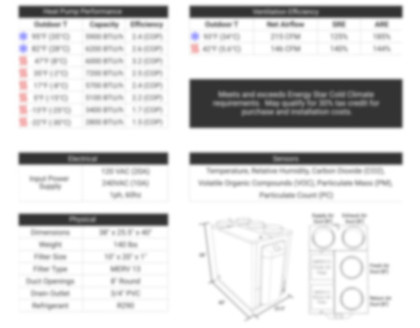
During this season of thanks, I found something to be truly thankful for. I jumped for joy while reading last week’s newspaper - a long list of building permits included 24 permits for rooftop residential solar systems! Ten years ago, there were no solar system permits listings, and no solar installers in our area. Now, there are more than 10 installation companies.
Our twin-city community (Urbana-Champaign Illinois) of 150,000 consists of approximately 60,000 residences. If we maintain 24 solar installation permits per week, 1250 homes per year, or 2% of our community’s homes are being transformed to more sustainable and economical operation.
Unfortunately, 2% per year means 50 years of installation to convert all homes to renewable energy. Utility scale solar and wind are also being installed at an accelerating rate, hopefully reducing our conversion to renewable energy within two decades. We need to convert as fast as possible to a renewable future in order to minimize the impacts of climate change and atmospheric carbon dioxide concentration increase.
Some pundits and critics state that the transition to renewable energy and electric transportation is happening too fast. A comparison of solar PV growth and EV (Electric Vehicle) transportation to the revolutionary technology transitions a century ago for the automobile, tractor, and refrigerator reveals that today’s growth rates for solar PV and EV technologies are sluggish. The comparisons are even more remarkable because there were no government programs, no tax credit rewards or punitive taxation driving yesteryear’s transition. Economic pressure, improved product performance, and individual preference drove the disruptive technology changes.
Hockey Stick Growth – Solar PV and EVs

Disruptive technologies, such as today’s renewable solar and wind energy technologies, and electric vehicles (EVs) are growing at an incredible rate. Rapid growth of a product or technology is often described as “hockey stick” growth because of slow initial growth of a new technology, followed by accelerated growth phase.
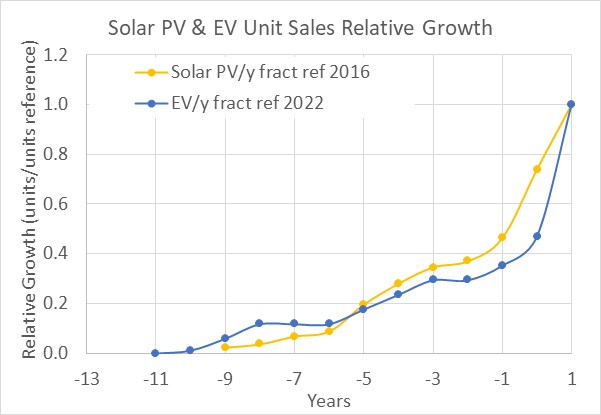
A plot of relative growth of solar PV and EVs shows we are emerging from the initial slow growth period and have entered the accelerated growth phase. The relative growth charts are based on a reference year selected at the beginning of the accelerated growth phase. Solar PV growth is a bit ahead of EVs by about 6 years, but in the overall scheme of things, these two remarkable, revolutionary technologies are moving into everyday life simultaneously. What does history tell us about accelerated growth of such important segments of our economy?
Automobiles, Tractors and Refrigerators

A century ago saw similar growth and technology displacements in many industries. Automobiles, tractors, refrigerators, clothes washers, aircraft, radio, television, vaccines, medical sciences, comfort conditioning and many other new technologies appeared. The washing machine reduced manual labor associated with clothes washing, allowing more work to be done with less effort. Refrigerators reduced the manual labor associated with delivering blocks of ice, improved food preservation, and reduced food spoilage and food-borne illness.
Plotting early growths of the automobile, tractor and electric refrigerator (Household Refrigeration, H.B. Hull, 3rd edition, Nickerson & Collins publishers, 1927) a century ago reveals that today’s solar PV and EV growths are not so fast. Tractors and automobiles transitioned from “horse” power to horsepower at similar rates, reaching accelerated growth within a couple of years of each other.
Refrigerator growth and ice box displacement is even more remarkable. As explained by H.B. Hull, an engineer involved in refrigerator industry growth, once electric refrigerator cost was within reach of ice box refrigeration cost, other advantages accelerated refrigerator adoption at a rate restrained by production and supply chain limits. Refrigerator adoption occurred 3 times faster than today’s relatively slow 10 year solar PV and EV initial phase growth.
Sustaining Hockey Stick Growth
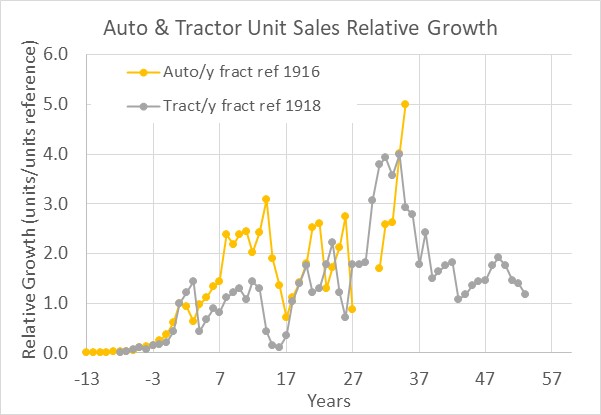
Various factors limit technology growth in addition to reaching saturation and transition to a mature market dominated by product replacement. We have the benefit of historic data for the automobile and tractor to view production variations over the past century.
Auto and tractor growth dropped in the early 1920s as the economy slowed, followed by another period of accelerated growth in the late 1920s. The great depression of the 1930’s crashed the growth of nearly every industry. As the depression eased, World War 2 restrained continued growth of auto and tractor. Once the war ended and factories were able to transition back to consumer goods, accelerated growth of both auto and tractor occurred.
Technology Adoption and Market Size
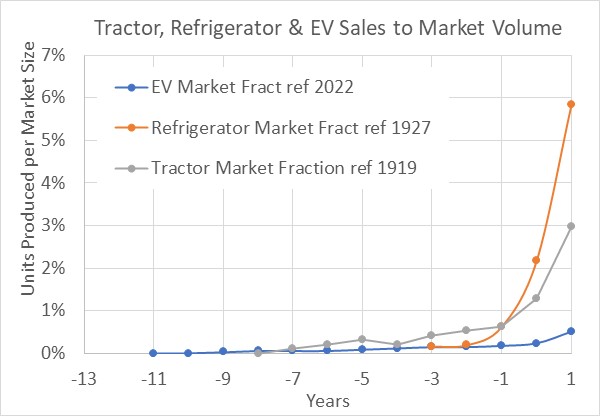
Another viewpoint to examine is the relative size of production to a market’s size. Ideally, one would like to grow a technology as fast as possible to meet demand while not overbuilding production capacity in order to smoothly transition to a mature, saturated replacement market. Determining the size of replacement demand is determined by the life expectancy of a product.

Refrigerators have a lifetime of 15 years, although the fashion aspect of refrigerators (eg, avocado green, stainless steel styles) may dictate replacement before functional lifetime comes to an end. A 15 year lifetime indicates that 6.7% of household refrigerators need to be replaced every year, while a 10 year lifetime requires 10% annual replacement. Cars and tractors are in a similar range of life expectancy, for a 6 to 12% annual replacement of existing product is a reasonable production capacity range.
During the early years of refrigerator (HB Hull estimated 12,000,000 electrified homes by 1927) and tractor growth (4,700,000 tractors in US), tractors and refrigerators grew at 3 to 6% of the estimated market size. By comparison, EVs in the US are displacing a 275,000,000 light vehicle market at a rate that is less than 1% of the market, and significantly less than a mature EV replacement market. Historical trends for tractors show unit production to average 4 to 6% of the tractor population. EV unit production fraction of the vehicle market is much lower than needed for its mature replacement market indicating plenty of room for accelerating EV growth.
Technology Losers - Slow Rolling Renewable Technology Advancement
Few overtly oppose transition to sustainable technologies, but there are individuals and organizations who publicly support the green revolution while doing everything possible to slow its progress. This New York Times article details one country’s efforts to continue pushing world dependence on oil to increase their wealth while touting their participation in greening the world. Fossil fuel companies, likewise, externally promote their support of renewable energy while internally stymying transition efforts. Both autocratic states and fossil fuel companies are using the well-worn playbook developed by tobacco, sugar and hydrogenated fat industries to create confusion and to financially support climate change deniers while simultaneously fabricating public service announcements proclaiming support for a sustainable future. The Case Against Sugar provides insight to commonly used delay tactics.
There is no doubt that renewable energy will win the energy war, but many battles remain to be fought to accelerate progression to a sustainable world. Just as horse and mule mongers shifted business activities as tractors displaced horses and mules, fossil fuel companies will also transition to different type business activities. Those future businesses will employ more people than the fossil fuel industry that rivals employment levels (0.25 employees per million $ revenue) of investment banks, health insurance companies and other corporations that don’t have to work for living. Companies that work for a living, manufacturing solar panels, batteries, heat pumps, and other consumer goods employ 3 to 5 people per million $ of revenue. We will feel ourselves getting richer as the transition happens!
A Bright Future
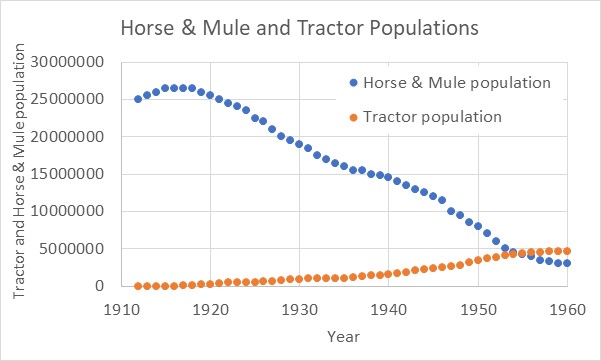
Movement to a sustainable future is also a transition to a more comfortable and healthy future. Economies based on energy efficient products, renewable energy harvesting, and circular material usage will result in more than enough food, goods and services for a stabilized world population. Diffuse renewable energy technologies also remove the ability of autocrats and monopolistic corporations to suppress population groups through their control of finite resources.
Transition to new technologies can have beneficial impacts beyond that of an individual’s personal benefit. Horses and mules required 20% of a farmer’s food production. William White estimates a phenomenal 8% increase in US GDP attributed to adoption of the tractor. Tractor production increased manufacturing employment as well.
We will see a similar increase in GDP as experienced during the tractor growth revolution. Product manufacturing, even in today’s automated world, employs 10 times more people per corporate revenue dollar than fossil fuel companies. Every dollar shifted from fossil fuel usage to manufacturing solar panels, batteries, and heat pumps brings stable employment opportunities to local communities.
The transition is our responsibility. No political party or government incentive programs are needed to help grow the market. Just as the early automobile, tractor and refrigerator, we individuals drive the market.
Are we growing too fast?
No!






